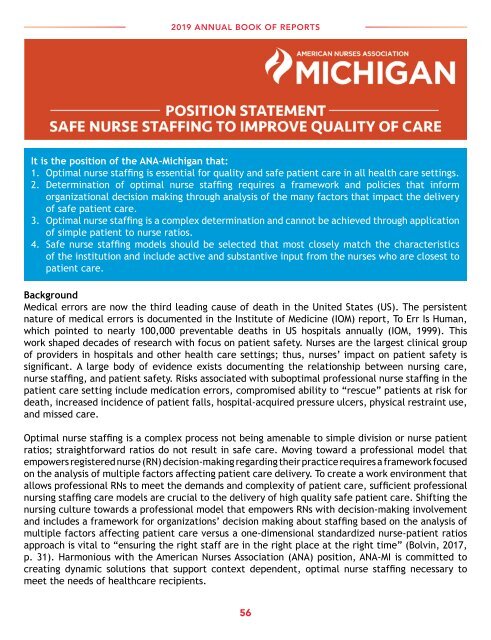Michigan 2019 Annual Report
- No tags were found...
Create successful ePaper yourself
Turn your PDF publications into a flip-book with our unique Google optimized e-Paper software.
<strong>2019</strong> ANNUAL BOOK OF REPORTS<br />
It is the position of the ANA-<strong>Michigan</strong> that:<br />
1. Optimal nurse staffing is essential for quality and safe patient care in all health care settings.<br />
2. Determination of optimal nurse staffing requires a framework and policies that inform<br />
organizational decision making through analysis of the many factors that impact the delivery<br />
of safe patient care.<br />
3. Optimal nurse staffing is a complex determination and cannot be achieved through application<br />
of simple patient to nurse ratios.<br />
4. Safe nurse staffing models should be selected that most closely match the characteristics<br />
of the institution and include active and substantive input from the nurses who are closest to<br />
patient care.<br />
Background<br />
Medical errors are now the third leading cause of death in the United States (US). The persistent<br />
nature of medical errors is documented in the Institute of Medicine (IOM) report, To Err Is Human,<br />
which pointed to nearly 100,000 preventable deaths in US hospitals annually (IOM, 1999). This<br />
work shaped decades of research with focus on patient safety. Nurses are the largest clinical group<br />
of providers in hospitals and other health care settings; thus, nurses’ impact on patient safety is<br />
significant. A large body of evidence exists documenting the relationship between nursing care,<br />
nurse staffing, and patient safety. Risks associated with suboptimal professional nurse staffing in the<br />
patient care setting include medication errors, compromised ability to “rescue” patients at risk for<br />
death, increased incidence of patient falls, hospital-acquired pressure ulcers, physical restraint use,<br />
and missed care.<br />
Optimal nurse staffing is a complex process not being amenable to simple division or nurse patient<br />
ratios; straightforward ratios do not result in safe care. Moving toward a professional model that<br />
empowers registered nurse (RN) decision-making regarding their practice requires a framework focused<br />
on the analysis of multiple factors affecting patient care delivery. To create a work environment that<br />
allows professional RNs to meet the demands and complexity of patient care, sufficient professional<br />
nursing staffing care models are crucial to the delivery of high quality safe patient care. Shifting the<br />
nursing culture towards a professional model that empowers RNs with decision-making involvement<br />
and includes a framework for organizations’ decision making about staffing based on the analysis of<br />
multiple factors affecting patient care versus a one-dimensional standardized nurse-patient ratios<br />
approach is vital to “ensuring the right staff are in the right place at the right time” (Bolvin, 2017,<br />
p. 31). Harmonious with the American Nurses Association (ANA) position, ANA-MI is committed to<br />
creating dynamic solutions that support context dependent, optimal nurse staffing necessary to<br />
meet the needs of healthcare recipients.<br />
56

















